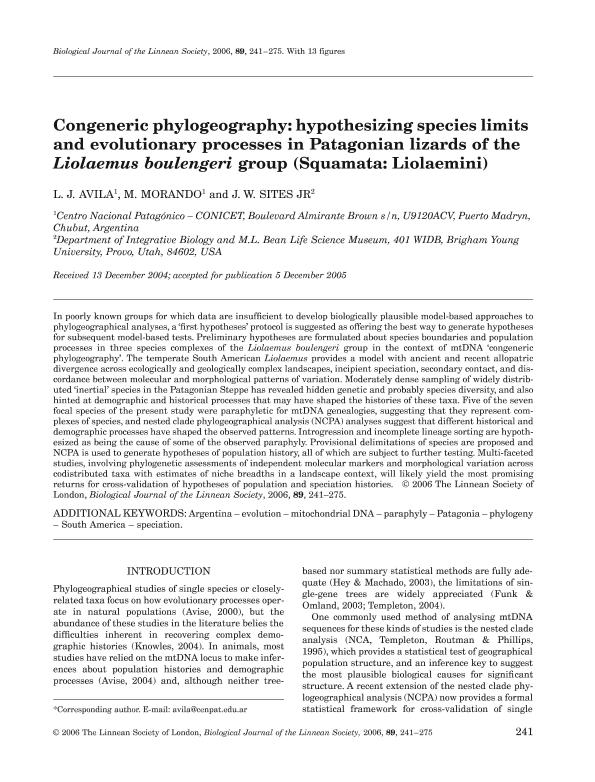Mostrar el registro sencillo del ítem
dc.contributor.author
Avila, Luciano Javier

dc.contributor.author
Morando, Mariana

dc.contributor.author
Sites, J. W.
dc.date.available
2020-04-23T16:27:21Z
dc.date.issued
2006-10
dc.identifier.citation
Avila, Luciano Javier; Morando, Mariana; Sites, J. W.; Congeneric phylogeography: hypothesizing species limits and evolutionary processes in Patagonian lizards of the Liolaemus boulengeri group (Squamata:Liolaemini); Oxford University Press; Biological Journal of The Linnean Society; 89; 2; 10-2006; 241-275
dc.identifier.issn
0024-4066
dc.identifier.uri
http://hdl.handle.net/11336/103464
dc.description.abstract
In poorly known groups for which data are insufficient to develop biologically plausible model-based approaches to phylogeographical analyses, a ‘first hypotheses’ protocol is suggested as offering the best way to generate hypotheses for subsequent model-based tests. Preliminary hypotheses are formulated about species boundaries and population processes in three species complexes of the Liolaemus boulengeri group in the context of mtDNA ‘congeneric phylogeography’. The temperate South American Liolaemus provides a model with ancient and recent allopatric divergence across ecologically and geologically complex landscapes, incipient speciation, secondary contact, and discordance between molecular and morphological patterns of variation. Moderately dense sampling of widely distributed ‘inertial’ species in the Patagonian Steppe has revealed hidden genetic and probably species diversity, and also hinted at demographic and historical processes that may have shaped the histories of these taxa. Five of the seven focal species of the present study were paraphyletic for mtDNA genealogies, suggesting that they represent complexes of species, and nested clade phylogeographical analysis (NCPA) analyses suggest that different historical and demographic processes have shaped the observed patterns. Introgression and incomplete lineage sorting are hypothesized as being the cause of some of the observed paraphyly. Provisional delimitations of species are proposed and NCPA is used to generate hypotheses of population history, all of which are subject to further testing. Multi-faceted studies, involving phylogenetic assessments of independent molecular markers and morphological variation across codistributed taxa with estimates of niche breadths in a landscape context, will likely yield the most promising returns for cross-validation of hypotheses of population and speciation histories.Liolaemus boulengeri group in the context of mtDNA ‘congeneric phylogeography’. The temperate South American Liolaemus provides a model with ancient and recent allopatric divergence across ecologically and geologically complex landscapes, incipient speciation, secondary contact, and discordance between molecular and morphological patterns of variation. Moderately dense sampling of widely distributed ‘inertial’ species in the Patagonian Steppe has revealed hidden genetic and probably species diversity, and also hinted at demographic and historical processes that may have shaped the histories of these taxa. Five of the seven focal species of the present study were paraphyletic for mtDNA genealogies, suggesting that they represent complexes of species, and nested clade phylogeographical analysis (NCPA) analyses suggest that different historical and demographic processes have shaped the observed patterns. Introgression and incomplete lineage sorting are hypothesized as being the cause of some of the observed paraphyly. Provisional delimitations of species are proposed and NCPA is used to generate hypotheses of population history, all of which are subject to further testing. Multi-faceted studies, involving phylogenetic assessments of independent molecular markers and morphological variation across codistributed taxa with estimates of niche breadths in a landscape context, will likely yield the most promising returns for cross-validation of hypotheses of population and speciation histories.
dc.format
application/pdf
dc.language.iso
eng
dc.publisher
Oxford University Press

dc.rights
info:eu-repo/semantics/openAccess
dc.rights.uri
https://creativecommons.org/licenses/by-nc-sa/2.5/ar/
dc.subject
ARGENTINA
dc.subject
EVOLUTION
dc.subject
MTDNA
dc.subject
PARAPHYLY
dc.subject
PATAGONIA
dc.subject
PHYLOGENY
dc.subject
SOUTH AMERICA
dc.subject
SPECIATION
dc.subject.classification
Biología

dc.subject.classification
Ciencias Biológicas

dc.subject.classification
CIENCIAS NATURALES Y EXACTAS

dc.title
Congeneric phylogeography: hypothesizing species limits and evolutionary processes in Patagonian lizards of the Liolaemus boulengeri group (Squamata:Liolaemini)
dc.type
info:eu-repo/semantics/article
dc.type
info:ar-repo/semantics/artículo
dc.type
info:eu-repo/semantics/publishedVersion
dc.date.updated
2020-04-06T16:07:09Z
dc.identifier.eissn
1095-8312
dc.journal.volume
89
dc.journal.number
2
dc.journal.pagination
241-275
dc.journal.pais
Reino Unido

dc.journal.ciudad
Londres
dc.conicet.avisoEditorial
Open Access
Biological Journal of the Linnean Society authors have the option to publish their paper under the Oxford Open initiative; whereby, for a charge, their paper will be made freely available online immediately upon publication.
dc.description.fil
Fil: Avila, Luciano Javier. Consejo Nacional de Investigaciones Científicas y Técnicas. Centro Científico Tecnológico Conicet - Centro Nacional Patagónico; Argentina
dc.description.fil
Fil: Morando, Mariana. Consejo Nacional de Investigaciones Científicas y Técnicas. Centro Científico Tecnológico Conicet - Centro Nacional Patagónico; Argentina
dc.description.fil
Fil: Sites, J. W.. University Brigham Young; Estados Unidos
dc.journal.title
Biological Journal of The Linnean Society

dc.relation.alternativeid
info:eu-repo/semantics/altIdentifier/doi/https://doi.org/10.1111/j.1095-8312.2006.00666.x
dc.relation.alternativeid
info:eu-repo/semantics/altIdentifier/url/https://academic.oup.com/biolinnean/article/89/2/241/2691576
Archivos asociados
